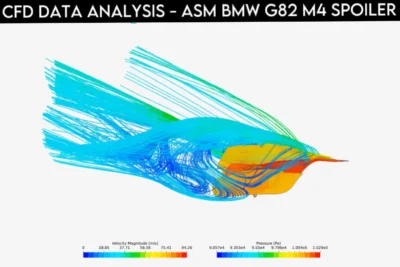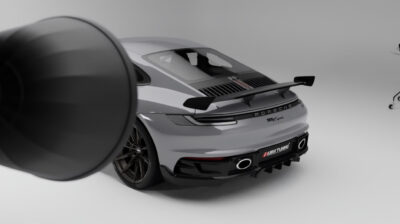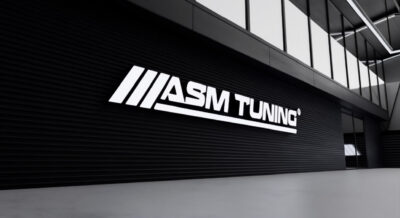Introduction
Rear‑end aerodynamics are a major part of vehicle tuning. Two popular devices—spoilers vs GT wings—both aim to improve stability and grip at speed. While they look similar, the way they manipulate airflow and generate downforce differs considerably.
Understanding these differences helps you choose the right solution for your driving goals. This blog compares spoilers and GT wings, explores carbon‑fibre construction, summarises the latest design trends, and explains how ASM Tuning’s engineering expertise can improve your car’s performance.
How spoilers and wings work
Spoiler basics
A spoiler is a raised lip or blade attached directly to the vehicle’s rear deck, roof or bumper. Its job is to disrupt the airflow that naturally flows over a car’s roof. Without a spoiler, fast‑moving air creates a low‑pressure zone behind the car, pulling the rear end upward and causing lift. A spoiler acts like a barrier, disturbing this airflow so that it separates and loses energy, reducing lift and.
Spoilers operate in opposition to lift, pressing the car more firmly to the ground and enhancing stability. When a spoiler is installed, there is less lift and airspeed, along with a reduction in aerodynamic drag.

Because spoilers are attached directly to the body (rear window, roof or trunk) and lie in the path of the airflow, they also create a small region of turbulent air behind the car. This turbulence lowers the pressure differential between the roof and the wake, further reducing drag and improving fuel efficiency.
Mechanic Base notes that spoilers were originally created for sports, rally and race cars but are now common on regular passenger cars; the air flows over the roof to the rear of the vehicle where the spoiler is mounted.
Wing basics
A GT wing is more like an inverted airplane wing. It is mounted above the trunk on pedestals, leaving a gap between the wing element and the car’s body. This airfoil shape has a curved suction side on top and a flat pressure side underneath.
As air flows over and under the wing, the curved upper surface deflects air downward, creating a lower pressure zone above the wing. The flatter lower surface deflects air outward, creating an area of higher air pressure below the wing.

This pressure difference pushes the wing—and thus the car—downwards, generating downforce. By capturing air coming from the roof and redirecting it upward, a wing presses the back of the car down, keeping the wheels planted.
Because a wing sits above the body and doesn’t interfere with airflow along the deck lid, it allows air to re‑attach smoothly behind the car. This helps maintain high‑speed stability and, if designed correctly, can reduce drag. However, if a wing’s angle of attack is too steep or the endplates are poorly designed, it can create unnecessary drag and turbulence.
Key functional differences
Mechanic Base summarises the fundamental difference succinctly: a wing deflects airflow upward to generate downforce, while a spoiler acts as a barrier to disrupt airflow and reduce lift. Carvibehub elaborates that car wings are designed to produce downforce, whereas spoilers reduce drag, which is the backward force exerted on the car by the air flowing over it.
By reducing drag, spoilers can increase top speed and improve overall aerodynamic efficiency. In other words, a wing turns air into a force pushing the car onto the road, whereas a spoiler keeps the car stable by decreasing the forces pulling it upward.

When deciding between the two, consider your vehicle’s purpose. Race and track cars benefit from the additional grip provided by a wing, especially during high‑speed cornering. Street and touring vehicles, where top speed and fuel efficiency matter, often use spoilers to manage drag and improve stability without excessive downforce.
Some performance road cars use a combination: a subtle rear lip spoiler for drag reduction and an adjustable wing for track days.
The advantages of carbon‑fibre construction
Lightweight strength and improved handling
Whether you choose a spoiler or wing, material choice affects performance. Carbon fibre has become the gold standard because it offers high stiffness with minimal weight.ASM Tuning article explains that carbon‑fibre spoilers combine lightness unmatched by traditional materials with incredible strength-to-weight ratio, allowing for better handling and increased speed.
A lighter rear end means less inertial resistance, so the car responds more quickly to steering inputs and accelerates faster, while the structure’s rigidity helps maintain aero shape at high speeds.
Improved fuel efficiency and sustainability
Reducing mass doesn’t just improve handling; it also enhances fuel economy because the engine expends less energy accelerating the vehicle. Carbon‑fibre spoilers and wings help vehicles meet stricter emissions regulations without sacrificing performance.
Carbon fibre is expensive due to complex manufacturing processes, but the pay‑off in enhanced performance justifies the expense. As technology advances and demand grows, carbon‑fibre components are becoming more common even in mainstream vehicles.
Aerodynamic efficiency and heat resistance
Carbon fibre can be moulded into complex shapes, enabling engineers to sculpt profiles that maximise downforce and minimise drag. Its high tensile strength prevents flexing under load, ensuring that wings and spoilers maintain their aero shapes at speed.
Carbon fibre is also heat‑ and corrosion‑resistant, making it ideal for parts that sit near hot exhausts or in harsh weather. When protected with UV‑resistant clear coats, carbon‑fibre aero parts retain their glossy weave and don’t yellow over time.
These attributes make carbon fibre the premium choice for high‑performance aero devices.
Sustainability and future trends
While carbon fibre manufacturing is energy‑intensive, automakers are exploring recycled or forged carbon composites to reduce waste. The Nottingham Car Wraps article quotes McLaren’s CEO, stating that carbon fibre has transformed the approach to maximising vehicle performance while keeping an eye on sustainability.
Expect future carbon‑fibre spoilers and wings to leverage recycled fibres and 3D‑printed patterns, reducing cost and environmental impact.
Design trends for 2025
The world of aero design is evolving quickly. Here are key trends shaping spoilers and GT wings in 2025:
-
CFD‑Optimised Profiles – Computational fluid dynamics (CFD) allows engineers to simulate airflow and adjust wing and spoiler geometry for maximum performance. ASM Tuning manufacturers now provide CFD data with their products, giving buyers confidence that the parts deliver real gains.
-
Active and adjustable aero – High‑end sports cars increasingly use active spoilers and multi‑element wings that deploy at certain speeds or angles to balance drag and downforce. Expect trickle‑down technology to more affordable performance models.
-
Integrated brake lights and styling cues – Spoilers now often include LED brake lights, while GT wings may feature sculpted endplates inspired by motorsport. These aesthetic touches complement the functional benefits.
-
Forged and recycled carbon – As sustainability becomes a priority, manufacturers explore forged carbon (randomly oriented fibres) and recycled composites, which retain many performance benefits at lower cost.
-
Model‑specific aero packages – Rather than universal wings, enthusiasts prefer kits tailored for specific vehicles (BMW M2/M3, Audi RS models, Nissan GT‑R, etc.) that ensure perfect fit and balanced aero. ASM Tuning uses 3D scanning and CAD modelling to design such packages.
Selecting the right rear downforce solution
Choosing between a spoiler and a GT wing depends on several factors:
-
Purpose of the car – Track‑focused builds benefit from the high downforce of a wing, while daily drivers and GT cruisers often prefer spoilers for moderate downforce and reduced drag.
-
Speed range – At sustained high speeds (above ~80 mph), a wing’s downforce is more effective. At moderate speeds, a spoiler can provide stability without unnecessary drag.
-
Vehicle design – The shape of your car’s body determines how air flows over the rear. Fastback coupes and sedans may benefit more from wings, whereas hatchbacks and SUVs often see gains from roof or lift spoilers.
-
Aesthetic preferences – Wings deliver an aggressive, motorsport‑inspired look. Spoilers can be more subtle but still add style. ASM Tuning offers both subtle lip spoilers and bold GT wings in dry or wet carbon finishes.
-
Legality and practicality – Some jurisdictions regulate the height and protrusion of aero devices. Ensure that a wing or spoiler complies with road‑use laws and doesn’t hamper rear visibility or trunk access.
If you’re unsure, consult an expert tuner. ASM Tuning’s team can recommend the right aero upgrade based on your goals and vehicle dynamics.
ASM Tuning: engineered solutions for real performance

ASM Tuning specialises in carbon‑fibre aerodynamic components. Each spoiler and wing starts with a 3D scan of the vehicle to capture every contour and mounting point. Engineers then use CAD modelling and CFD simulations to optimise the part for downforce, drag and fitment. Prototypes are track‑tested before final production to verify results.
ASM manufactures its aero components from dry prepreg carbon fibre for superior strength and low weight. Parts are finished with UV‑resistant clear coats to protect against fading. Because they are model‑specific, ASM spoilers and wings bolt directly to factory mounting points without drilling.
By choosing ASM, you get aero parts that offer real performance benefits—not just styling accessories. Whether you need a subtle carbon‑fibre lip spoiler for your M3 or an adjustable GT wing for your track‑prepped RS3, ASM provides solutions backed by data and craftsmanship.
FAQs
Do spoilers increase top speed?
Yes – by reducing drag, spoilers can improve a car’s top speed and fuel economy. However, poorly designed spoilers may increase drag, so quality and proper fitment are important.
Are GT wings legal on public roads?
Regulations vary by country. In the UK, wings and spoilers must not protrude excessively or have sharp edges. Always check local laws and choose parts designed for road use.
How do I maintain carbon‑fibre aero parts?
Wash them using non‑abrasive cleaners and apply UV‑protective wax or ceramic coating. Inspect regularly for chips and cracks. Avoid leaning heavy objects on wings or spoilers.
Conclusion
Spoilers and GT wings are both effective tools for managing airflow and improving vehicle stability. Spoilers disrupt airflow to reduce drag and moderate lift, making them ideal for street performance and fuel efficiency.
Wings act as inverted airfoils, generating significant downforce to keep the rear planted at high speed—perfect for track use and aggressive driving. Carbon‑fibre construction enhances both devices by reducing weight, increasing strength and enabling complex shapes.



